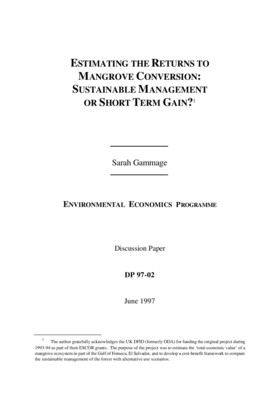Estimating the returns to mangrove conversion: sustainable management or short term gain?

The purpose of this project is to estimate the ‘total economic value’ of a mangrove ecosystem in part of the Gulf of Fonseca, El Salvador, and to develop a cost-benefit framework to compare the sustainable management of the forest with alternative use scenarios. The current management strategy is compared to its sustainable counterpart, and to the partial conversion of the mangrove ecosystem to semi-intensive aquaculture and salt ponds. A variety of different valuation techniques are used to assess the contribution of different products and services of the mangrove ecosystem. Among these techniques, a ‘pseudo production function approach’ is used to calculate dose-response estimates of the impact of mangrove loss on the productivity of marine and estuarine fisheries. The valuation exercise yields the result that the sustainable management strategy enables more timber and fisheries benefits to be captured over a horizon of 56 years than do the other management options. This supports the view that the allocation of usufruct rights and the sanctioned conversion of mangrove forest to artificial shrimp ponds reduces the net benefits available to society, and that such policy failures accelerate the loss of biodiversity and compound existing market failures. The research was highly participatory and involved the community in the measurement and articulation of the value of the mangroves. As such, it is one of the first valuation exercises to incorporate a community definition of sustainable management - one which reflects the revealed preference valuations of the community and which is in harmony with their management concerns.
Cite this publication
Available at https://www.iied.org/8092iied